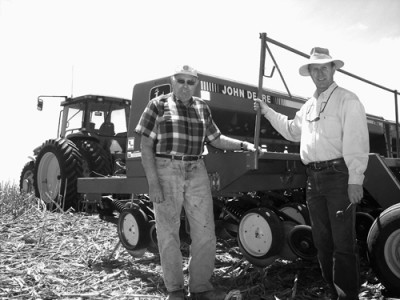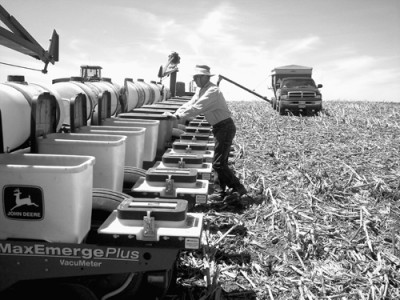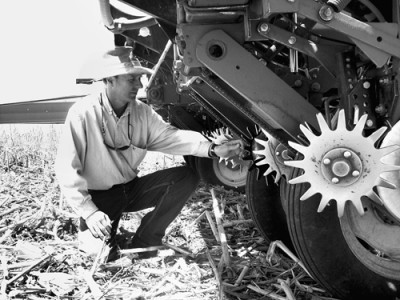When we decided that we wanted to no-till corn back in 1994, we knew we would face a tough challenge from our cold, wet spring soils. So, my brother Steve and I (with the support of our Dad, Dave) decided to try fall strip-tilling.
|
|
Since there were no turnkey strip-till machines available in the size that we wanted, we built our own. The modified anhydrous applicator, assembled with the help of local machine-shop welders, was probably the first 12-row, strip-till rig in our area of southwestern Minnesota.
At that time, we were already convinced of the value of no-tilling, based on 6 years of planting soybeans (starting in 1988) with 750 John Deere no-till drills. We knew the effect that crop residue could have in preventing runoff and wind erosion. We could see our topsoil was getting mellower and more absorbent with no-till. We liked the time and money savings from fewer trips across the field.
Still, we didn’t yet have a true “no-till system,” since we were still running a field cultivator in the spring before planting corn.
Because part of our land is classified as highly erodible (HEL), we were required by the Farm Bill to leave at least 30% residue on the surface of the HEL acres to qualify for government payments. This put us in a bit of a quandary, because any fall tillage operation was sure to drop the residue cover below 30%.
At the same time, farmers who had tried no-tilling corn were reporting slow germination and poor stands when they planted into residue covering the cold, wet spring soils that are typical of Minnesota.
Learning From Experience
|
Check The Specs... |
Our search for answers led us to Jim Kinsella in Lexington, Ill. Jim was a true pioneer and early advocate of fall strip-till, spreading the word about this “best of both worlds” He described it as creating a warm and dry seed zone in the spring, while leaving an environment for cooler and wetter row middles during the hot summer months.
Following Jim’s advice, we proceeded to build a 12-row, 30-inch strip-till machine with an air injection system for dry fertilizer.
First, we located a 5-ton hopper for carrying phosphorus and potassium. We used a stiff anhydrous C-shank acquired from Progressive Farm Products, Inc. in Hudson, Ill., and added 9-inch sealing discs in the rear.
By the end of our first year, we knew those weren’t big enough, so we went with 16-inch sealing discs and, again following Jim Kinsella’s advice, mounted a mole knife similar to a subsoiler point on the anhydrous shank.
After those modifications, we were able to apply anhydrous ammonia as well as phosphorus and potassium with the air delivery system at about a 6-inch depth. At the same time, we created a berm that was 8 inches wide, 6 to 8 inches deep and 6 inches tall. Row markers helped keep the strips straight across the field, as practical automated steering was still several years away.
By the following spring, the berm had settled down to a height of 2 inches. We were pleased to find that the softer soil in the strips tended to pull the planter into them, so keeping the row units centered on the tilled area was fairly easy.
We enjoyed significant fertilizer savings from day one. By banding phosphorus and potassium under the rows, we were able to cut back on rates, saving about $10 per acre.
No Yield Loss
|
|
In those early years, we closely monitored yields in the strip-tilled cornfields but never measured any loss, compared to what we had been getting with multiple fall tillage operations.
When we factored in the labor, fuel and equipment wear that we were saving with only one fall field pass and no pre-plant tillage in the spring, our bottom line was suddenly much better.
When we had to wait until late fall temperatures got cold enough to apply anhydrous ammonia, it was easy to get into a time jam trying to cover up to 1,800 acres before freeze-up. So we shifted from applying anhydrous to sidedressing nitrogen in order to start strip-tilling right after harvest.
We used a John Deere 12-row 7200 planter during those first 10 years of strip-tilling. We found that row cleaners are the only planter attachments needed for strip-tillage.
The row cleaners are set very shallow, so they gently move residue and clumps away from the tilled strip without aggressive soil movement. It results in an almost perfect seedbed. We don’t need any down pressure on the planter in the mellow strips.
Custom Strip-Till
That system worked well and we continued with it until 4 years ago. When our local ag supply dealer, Country Pride Services Cooperative, saw a growing demand for strip-tilling in their marketing area, the company invested in new 16-row Redball equipment and added fall strip-tilling to its service menu.
The co-op’s machines, equipped for RTK automatic steering, can apply both anhydrous and dry phosphorus and potassium, so we have now shifted back to fall nitrogen application. Utilizing this custom strip-till service has freed up our fall schedule and the charge of $15 per acre (plus fertilizer cost) is well worth it.
If we were doing multiple tillage operations, the cost would be much higher. With RTK, the co-op leaves perfectly straight strips.
This year, we traded up to a John Deere 8220 tractor that is auto-steer ready. Keeping the planter on the strip is now as trouble-free as you can get.
We are fortunate that an area John Deere dealer has constructed towers for RTK, so we did not have to invest in a local base station for receiving satellite signals.
Easier, Cheaper Weed Control
We also use the RTK-equipped tractor to pull a 1,600-gallon sprayer, a rig that we use a lot on Roundup Ready soybeans and the new Roundup Ready corn varieties. We can spray 160 acres with 10 gallons of fuel, a fraction of what it would cost to fight weeds with steel.
|
|
A sprayer investment is a good decision for anyone farming as many acres of Roundup Ready crops as we do.
Good weed management calls for spraying when weeds are very small (even before they have all emerged) and any delay will result in lost yield. We keep Roundup rates as low as possible and add 2,4-D to the tank for burndown applications.
A decrease in weed pressure is another benefit of long-term no-tilling. Weeds like to be “planted,” which occurs with frequent tillage. With no-tillage, we don’t plant weed seeds anymore. They stay buried in the soil, even though the seeds might remain viable for 30 years or more.
30-Inch Corn And Beans
Last year, we upgraded to a 16-row planter. Again, we have only added row openers, with no special down pressure needed for strip-till planting.
We did equip the planter to dribble pop-up fertilizer on the seed and think the no-till corn is a little greener in the spring. As others have reported, it appears that the corn getting starter fertilizer is a couple of points lower in moisture at harvest, saving high-priced natural gas that’s needed in the crop dryer.
|
—TOM MULLER |
To speed up planting, we no-till corn and a good share of our no-till soybeans in 30-inch rows with the John Deere 1770 planter. Since we still no-till some soybeans with the 30-foot John Deere 750 drill in 10-inch rows, it’s easy to check any difference on the combine yield monitor.
So far, we don’t see any penalty with the wider row spacing. It’s true that the 30-inch beans don’t canopy as quickly (in fact, sometimes they don’t ever cover the row), but that’s not a problem if you’re willing to compensate with timely spraying. We are careful about selecting fields where we plant in 30-inch rows; on sandy soil, the 10-inch rows with their quick canopy are still best.
We’ve reduced soybean seeding rates from 180,000 to between 160,000 and 170,000 in the 10-inch-row soybeans and down to about 155,000 in the 30-inch rows, without affecting our 45-bushel-per-acre, long-term yield average.
The trend to continuous corn is worth watching, but we feel crop rotation is the best choice for us, considering current soybean prices. There’s also the 50 pounds per acre of nitrogen that soybeans generate for the following corn crop.
In addition to adding some Roundup Ready corn to the mix, we select triple-stacked hybrids for corn borer and corn rootworm protection. Our first comparisons would indicate genetic corn rootworm protection is more effective than soil insecticides. We apply banded Aztec insecticide through Smart Boxes for secondary pests.
More No-Tilled Wheat
We’re slowly expanding our no-till spring wheat acreage (160 acres in 2008) to give us a third crop. We believe that adding another crop to the rotation, especially a deep-rooted cereal crop, helps build soil quality while interrupting the life cycles of soil-borne pests, such as the soybean cyst nematode.
No-till spring wheat, planted into soybean stubble with the 750 drill, helps spread out labor and machine use. We’re fortunate to be able to raise high-quality premium varieties and have markets in close proximity.
On-Farm Research
We were among 10 Minnesota farms involved in a statewide tillage comparison study conducted by the University of Minnesota and Monsanto in 2004 and 2005.
The overall results supported our belief that strip-tilling is a very viable choice for our soils and climate. Strip-till yields across all of the cooperating farms averaged 188 bushels per acre, compared to 190 for chisel-plus, 185 for one-pass and 180 for no-till.
On our farm, strip-till plots outyielded all of the other tillage treatments in 2005. Even in 2004, when the chisel-plowed plot yields were slightly higher, strip-tilling returned the most profit per acre when labor, fuel and equipment costs were factored in.
Perhaps just as important was one conclusion of the research team. They noted that “strip-till can produce yields similar to conventional-tillage systems like chisel plow, while maintaining adequate residue cover and reducing the risk of soil erosion.”
As a result of the research program, we were asked by the local soil conservation district, the Minnesota Department of Natural Resources and other agencies to hold field days at our farm so growers could see firsthand how strip-tilling combines bottom-line benefits with long-term soil conservation goals.
Stick With It
The best advice we can give to other farmers who try strip-tilling is to give it time to work. Strip-till your best soils (not your worst) and compare what happens vs. aggressive tillage.
Our experience shows that it takes about 5 years before the soil starts responding to no-till and strip-till. But even during the transition period on our farm, bottom-line comparisons showed we didn’t lose any money.
We soon learned that earthworms could do more tillage than a moldboard plow by helping to break up hardpan soils, while providing millions of channels for air and water to infiltrate into the soil profile. Worm populations have exploded in the 21 years that we’ve been no-tilling.
Long-term no-till “drought-proofs” the soil. During the last two dry summers, corn and soybeans grown in tilled fields in our area showed severe wilt in mid-July. However, our no-till fields just kept going, relying on moisture stored in the soil profile.
When it did rain heavily in the fall, the soil acted like a sponge and water soaked straight down. Long-term tillage, on the other hand, turns the soil into a powder that cakes up and seals the surface with the first 0.1-inch of rain. The rest runs off and heads downstream.
Even after a 5-inch rain during harvest, we’re able to get back into the field with the combine in only a day or two.
We’ve learned that money spent on tiling, rather then tilling, is smart money. We often share tile installation costs on strip-tilled rented land because it pays back so quickly and creates good landlord relationships. Even with the competition for land, we’ve had most of the farms we rent for 5 years or more.
On the land that we custom farm, landowners have often switched over to no-till and strip-till, based on seeing what has happened on our farm.
Finally, no-till and strip-till provides more time to spend with your family or for expanding your business. Three of us could not farm 2,800 acres with a conventional-till system without working many more long days in the field and/or hiring additional labor.

 ROW SPACINGS HAVEN’T MATTERED. Dave and Tom Muller first started no-tilling soybeans back in 1988. With timely pesticide spraying, they haven’t seen any yield differences between 30-inch and 10-inch soybean row spacings.
ROW SPACINGS HAVEN’T MATTERED. Dave and Tom Muller first started no-tilling soybeans back in 1988. With timely pesticide spraying, they haven’t seen any yield differences between 30-inch and 10-inch soybean row spacings. DOUBLE-DUTY NO-TILL SEEDING USAGE. The Muller’s 16-row planter is used to plant both strip-tilled corn and no-till soybeans in 30-inch rows.
DOUBLE-DUTY NO-TILL SEEDING USAGE. The Muller’s 16-row planter is used to plant both strip-tilled corn and no-till soybeans in 30-inch rows. HOLD DOWN EQUIPMENT INVESTMENT. Row cleaners and popup fertilizer attachments are the only planter “add-ons” Tom Muller finds are required for producing high-yielding strip-tilled corn.
HOLD DOWN EQUIPMENT INVESTMENT. Row cleaners and popup fertilizer attachments are the only planter “add-ons” Tom Muller finds are required for producing high-yielding strip-tilled corn.




